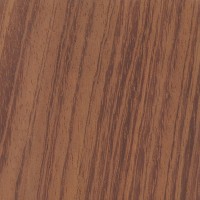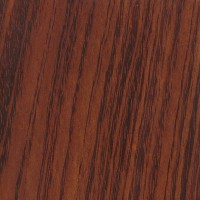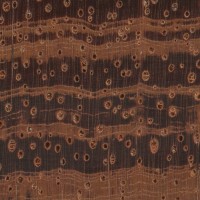 |
Common Name(s): Rengas, Borneo Rosewood, Tiger Rengas
Scientific Name: Gluta spp. and Melanorrhoea spp. Distribution: From India to Papua New Guinea Tree Size: 100-130 ft (30-40 m) tall, 2-4 ft (.6-1.2 m) trunk diameter Average Dried Weight: 48 lbs/ft3 (765 kg/m3) Specific Gravity (Basic, 12% MC): .63, .76 Janka Hardness: 1,720 lbf (7,650 N) Modulus of Rupture: 13,100 lbf/in2 (90.3 MPa) Elastic Modulus: 1,915,000 lbf/in2 (13.20 GPa) Crushing Strength: 8,380 lbf/in2 (57.8 MPa) Shrinkage: Radial: 2.9%, Tangential: 5.3%, Volumetric: 8.2%, T/R Ratio: 1.8 |
Color/Appearance: Heartwood is a deep red with darker streaks, while the sapwood is a lighter pinkish-brown to almost white. Heartwood will darken in color upon exposure to light and air. Sapwood especially is said to be highly irritating to some individuals. Striped pieces are sometimes called Tiger Rengas.
Grain/Texture: Has a fine to medium texture with typically straight or slightly irregular grain.
Endgrain: Diffuse-porous; large to very large pores in no specific arrangement, very few; solitary and radial multiples of 2-3; tyloses present; narrow rays barely visible without lens, spacing normal to fairly close; parenchyma vasicentric, banded, and marginal. Depending on species, heartwood may be fluorescent and/or have extractives readily leaching out in contact with water.
Rot Resistance: Rated as moderately durable, though not resistant to termites or other insects.
Workability: Severely dulls cutting tools due to a high silica content. Otherwise, wood is fairly easy to work and glues and finishes well.
Odor: May have a distinct odor depending on species.
Allergies/Toxicity: The sap of Rengas is reported to be strongly irritating to the skin, causing blisters, sores, and reactions similar to poison ivy, as well as fever and constitutional effects in some individuals. See the articles Wood Allergies and Toxicity and Wood Dust Safety for more information.
Pricing/Availability: Occasionally available as turning or craft blanks. Expect prices to be in the mid to upper range for an imported hardwood.
Sustainability: Rengas is not listed in the CITES Appendices, and several species in the Gluta genus are reported by the IUCN as being of least concern; an exception is Gluta papuana, a species endemic to New Guinea, which is reported as vulnerable due to a population reduction of over 20% in the past three generations, caused by a decline in its natural range, and exploitation.
Common Uses: Turned objects, cabinetry, furniture, and other specialty wood items.
Comments: It has been reported that Rengas is an excellent and handsome wood for cabinetry and other projects, but that the tree is so highly irritating among foresters and end-users, that it has fallen out of favor. The sap contains urushiol (the same allergen found in Poison Ivy), and can still be irritating to some sensitized individuals even after the wood has been dried, and sap can also seep through some wood finishes to the surface of the wood.
Sometimes referred to as Borneo Rosewood, it is not closely related to the true rosewoods (Dalbergia genus), but is rather contained in the Anacardiaceae family, (which includes poison ivy).
None available.








2 summers ago, there was a pile of pallets, in the parking lot of “Canadian Tire”; being incurable “wood-aholic”, I pulled over, to investigate….SCORE! I found just one slat on one pallet, made of rengas…..I made these hairpins from it..”DEAD-ringer”, for cocobolo…
Nice hairpins, what did you use for a finish on them?
thanx Bob! I used OSMO UV Protection oil clear 410; it’s ok, but the water resistance doesn’t seem to be the best, so I might try some other options, if I can find….I like oil finishes for most of my craft items; for years I used ” Behr Tung Oil/UVI” finish, but they discontinued it, some years ago…as I use a lot of exotics, I like a UVI finish, to give the colors a “fighting chance”….
Thanks for the reply, I’m not too worried about water resistance, I’m looking at building an electric guitar kit that has the body made from rengas and I have no experience in woodworking beyond high school shop decades ago! Thanks for the help!
I woud say it is a bit “stringy” in the grain, + it is also noted for potential toxicity, so watch the dust!..apparently the loggers hate it, for producing poison-ivy-like resuts, from cutting into the bark…I didn’t have any reactions, as I made these pins….
I would like to identify the wood in the pic attached. I’ve only looked at the pink woods but the nearest I can get is Rengas but I don’t think that is correct. Are you able to help please? It is a pink wood, tightly grained (14 rings in 10mm = 0.7mm per ring). It is quite dusty to work on a lathe. I think it might have been in amongst a few offcuts picked up from a boat workshop but that could be wrong. Pics attached are a low powered microscope shot of the end grain, a pic of… Read more »
Looking at the endgrain, it appears to be a man-made product made of several thin plies of solid wood, but unlike plywood, all of the plies are going in the same direction. I’m not sure what species of wood it could be. It appears to have fairly large rays and large diffuse pores.
Hi Eric and thank you. Yes, I can see why you mention man made but there is no thickness to what would be the glue lines and, looking at the unfinished block of wood, I’m sure it’s natural. It would have to be very thin veneers and the wood doesn’t seem to be a good enough quality to bother with that. It’s fairly low density.
I’m now wondering whether it could be a Keruing species but that isn’t described as pink and, looking at your illustrations, there are other differences. Would any other pics help?
Keruing is a decent guess, but the sample you have appears to have very infrequent pores, while keruing tends to have much more closely packed pores. But I’m not sure how much variation there can be since the wood encompasses several species in the Dipterocarpus genus. But if you look closely at the endgrain in your first picture, you can see where one ply ends and another begins, and even individual pores that have been sheared/cut off right down the middle. Also, the vertical lines in the endgrain are rays, and they should be continuous across the entire length of… Read more »
I’ve looked more closely and searched online and discovered LVL (laminated veneer lumber). I hadn’t come across it previously so this has been a learning experience for me. Very thin veneers glued together. Unlike plywood, the orientation of veneers is all in one direction. I still don’t know what wood my particular sample is but at least I understand it better. Thank you for your help.
The wood pictured below actually worked and cut easier than I thought it would. It planed off the saw marks and sanded similar in texture to mahogany. Not like a rock as some rosewoods can be. Any help appreciated – as I’ve got a bunch.
I’m not sure if I just picked up some rengas. It looks similar to the Indian Rosewood it’s pictured with, but no rosewood smell. What do you think? It came in a lot of exotics, most of which the seller said came from New Guinea.
Hard to tell, the endgrain image falls just short of the needed clarity to see what the pattern of the parenchyma might be. If it’s from New Guinea, that would certainly narrow it down. Possible to get a clearer image of the endgrain?
I can try. I shot it through a magnifer. Will give it another shot. Thanks! The only other hint I got from the seller on the pile is that there might be some African Mahogany in the pile. This stuff works like mahog – but no smell.
the rough sawn board looks like the rengas i picked up but the end graine that your showing is like Eric said the clarity isnt there enough for me to second that but the big board looks exactly like Rengas. Also just for your information i have to wear a full hazmat suit to work with Rengas! I found that out the hard ivy way!
I have to agree with you Kevin…..a while back I was purchasing so wood for turning purposes and decided to go a little exotic I place a $0.99 bid without having read the discription ( I know buying by the photo is a recipe for disaster lol), anyway I accidentally won the auction and as shipping was free I still did not realise till I got the Rengas that I noticed it was a 4 foot 2×6……but as soon as I saw it I knew this would make the most beautiful coffee table top….now I just have to figure out… Read more »
Hello, i have identified a piece of timber i have cut from a truck skid!! To be a piece of this rengas timber.
Beautiful piece of timber clear defining where heartwood meets the sapwood.
thought id share :)